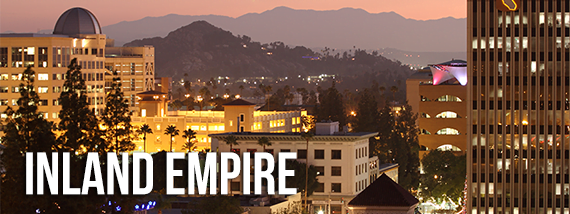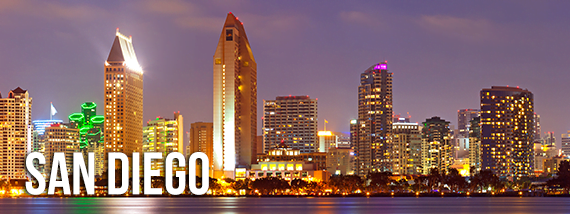The commercial real estate environment is continually improving in California as our economy has finally entered a period of expansion.
Jobs surpassed their peak pre-recession level in 2014 and the rate of new employment is exceeding the hot pace of the late 1990s, with upwards of 70,000 new jobs added each month in California. All this employment is increasing demand for office space, apartments and eventually (but not quite yet) retail space. Once the employment market reaches a full post-population growth recovery — likely in 2019 — expect the commercial real estate market to be fully recovered.
As residents’ wallets become full once more, the retail industry continues to recover at a cautious, but steady pace in 2016.
Vacant commercial property was mostly down across the state, a good sign for future construction and prices. Once vacancies fall on demand for more space, prices will rise more quickly and builders and their lenders will seize the opportunity to begin new construction.
Absorption — the amount of space becoming occupied each quarter — was positive across Southern California markets, after mixed absorption experienced in the previous quarter.
How did your region fare? Industrial, office and retail are covered across the following regions, courtesy of Voit Real Estate Services:
- the Inland Empire;
- Los Angeles;
- Orange County; and
- San Diego.
Check out the details that follow, or visit Voit for even more specifics (you’ll need to sign up for a free Voit account to access their data).

The Inland Empire’s commercial market is defined by its sprawling industrial buildings, by far its largest commercial sector. Burgeoning construction activity is promising in the third quarter (Q3) of 2016, with 18.6 million square feet of industrial space under construction in the Inland Empire.
Though office market data is unavailable for Q3 2016, the Inland Empire’s office market has been struggling through its slow recovery, with a high vacancy rate (soon to be remedied due to low levels of construction) and a sluggish absorption rate.
Industrial

 Construction: A significant 18.6 million square feet of industrial space was under construction in the Inland Empire during Q2 2016, across 82 buildings.
Construction: A significant 18.6 million square feet of industrial space was under construction in the Inland Empire during Q2 2016, across 82 buildings.
 Vacancy:
Vacancy:
Unoccupied industrial space was at 5.3% in Q3 2016. This is up from 5% in the previous quarter and up from 5.1% a year earlier. Temecula Valley has the lowest overall vacancy rate of 2.7%. With plenty of new construction in the works, Voit anticipates higher vacancy rates in the coming quarters.
 Availability: Industrial space marketed for sale or lease was at 7%, down from 7.3% in the previous quarter. Availability continues to fall, signaling the need for more construction, which builders are eagerly in the process of meeting with 18.6 million square feet of industrial space under construction in Q3 2016.
Availability: Industrial space marketed for sale or lease was at 7%, down from 7.3% in the previous quarter. Availability continues to fall, signaling the need for more construction, which builders are eagerly in the process of meeting with 18.6 million square feet of industrial space under construction in Q3 2016.
 Absorption: The Inland Empire experienced 8.1 million square feet of positive net absorption in Q3 2016, up significantly from the prior quarter. In other words, much more industrial space became occupied than became vacant. Absorption has been positive in the Inland Empire’s industrial market since 2010.
Absorption: The Inland Empire experienced 8.1 million square feet of positive net absorption in Q3 2016, up significantly from the prior quarter. In other words, much more industrial space became occupied than became vacant. Absorption has been positive in the Inland Empire’s industrial market since 2010.
 Transactions: 13.5 million square feet of industrial space was leased or sold in Q3 2016, down from the previous quarter when 16.7 million square feet was leased. The largest industrial spaces leased in the Inland Empire during Q3 2016 went to Floor & Decor outlet in Moreno Valley and Walmart in Fontana.
Transactions: 13.5 million square feet of industrial space was leased or sold in Q3 2016, down from the previous quarter when 16.7 million square feet was leased. The largest industrial spaces leased in the Inland Empire during Q3 2016 went to Floor & Decor outlet in Moreno Valley and Walmart in Fontana.

Los Angeles has one of the lowest industrial vacancy rates in the nation, at just under 2%. It’s a good time to own industrial space in Los Angeles, as vacancies are down and lease rates are up.
Industrial

 Construction: Nearly 5 million square feet of industrial space was under construction throughout the Los Angeles area Q3 2016. The area’s low vacancy rate continues to spur on more construction, and builders are rising to the occasion.
Construction: Nearly 5 million square feet of industrial space was under construction throughout the Los Angeles area Q3 2016. The area’s low vacancy rate continues to spur on more construction, and builders are rising to the occasion.
 Vacancy: Total unoccupied industrial space was very low in Q3 2016, just under 2%, continuing the downward trend in vacancies and pushing rents higher.
Vacancy: Total unoccupied industrial space was very low in Q3 2016, just under 2%, continuing the downward trend in vacancies and pushing rents higher.
 Availability: Industrial space being marketed was just below 4%. This also continues a downward trend, as inventory available is quickly leased or sold in Los Angeles.
Availability: Industrial space being marketed was just below 4%. This also continues a downward trend, as inventory available is quickly leased or sold in Los Angeles.
 Absorption: There was 604,000 square feet of positive net absorption in the Los Angeles industrial market during Q4 2016. While this is less than the previous quarter when 1.3 million square feet of positive absorption took place, this still continues a two-year trend of positive net absorption.
Absorption: There was 604,000 square feet of positive net absorption in the Los Angeles industrial market during Q4 2016. While this is less than the previous quarter when 1.3 million square feet of positive absorption took place, this still continues a two-year trend of positive net absorption.
 Transactions: 10.1 million square feet of industrial space was leased in Q3 2016, down slightly from a year earlier. This decrease is due primarily to less inventory available for lease. As available inventory has shrunk, the asking rate for industrial lease space has increased 10% from a year earlier.
Transactions: 10.1 million square feet of industrial space was leased in Q3 2016, down slightly from a year earlier. This decrease is due primarily to less inventory available for lease. As available inventory has shrunk, the asking rate for industrial lease space has increased 10% from a year earlier.

The industrial sector is heading into a period of expansion in Orange County. The industrial vacancy rate was at 2.3% in Q3 2016, up slightly from an all-time low experienced in late 2015. Today’s low vacancy rate is soon to be countered by high levels of construction.
While not as recovered as Orange County’s other commercial markets, the office real estate market mostly improved in Q3 2016, and new construction is expected to pick up in the coming year.
Industrial

 Construction: There was 310,000 square feet of industrial space under construction, spanning just three new buildings, in Orange County during Q3 2016. The high cost of land in Orange County makes smaller projects less profitable, so most of this new construction consists of large industrial space.
Construction: There was 310,000 square feet of industrial space under construction, spanning just three new buildings, in Orange County during Q3 2016. The high cost of land in Orange County makes smaller projects less profitable, so most of this new construction consists of large industrial space.
 Vacancy: Total unoccupied industrial space was 2.3% in Q3 2016, down slightly from the prior quarter and near a record low for the region. The lowest industrial vacancy rate is 1.7% in the North County submarket.
Vacancy: Total unoccupied industrial space was 2.3% in Q3 2016, down slightly from the prior quarter and near a record low for the region. The lowest industrial vacancy rate is 1.7% in the North County submarket.
 Availability: 3.7% of industrial space was being marketed for sale or lease in Q3 2016, down from the previous quarter when 4% was being marketed.
Availability: 3.7% of industrial space was being marketed for sale or lease in Q3 2016, down from the previous quarter when 4% was being marketed.
 Absorption: There was 439,000 square feet of positive net absorption in Q3 2016, much better than the negative net absorption experienced in the previous quarter. This means more space became vacant than occupied during this quarter.
Absorption: There was 439,000 square feet of positive net absorption in Q3 2016, much better than the negative net absorption experienced in the previous quarter. This means more space became vacant than occupied during this quarter.
 Transactions: 4.7 million square feet of industrial space was leased in Q3 2016, down 8% from this same time last year. Asking lease rates are up 19% from a year ago and sale prices are 26% higher than this time last year, reflecting investor confidence in Orange County’s tight industrial market.
Transactions: 4.7 million square feet of industrial space was leased in Q3 2016, down 8% from this same time last year. Asking lease rates are up 19% from a year ago and sale prices are 26% higher than this time last year, reflecting investor confidence in Orange County’s tight industrial market.
Office

 Construction: 2.4 million square feet of office space was under construction in Orange County during Q3 2016, the same as the prior quarter. Voit reports numerous construction plans are in the pipeline, which means an increase in construction in the coming months.
Construction: 2.4 million square feet of office space was under construction in Orange County during Q3 2016, the same as the prior quarter. Voit reports numerous construction plans are in the pipeline, which means an increase in construction in the coming months.

Vacancy: 10.2% of office space sat vacant in Q3 2016, down slightly from 10.5% a year earlier. The office sector has improved considerably from the 18% high experienced during the Great Recession.
 Availability: Office space being marketed for sale or lease was at 15.1%, up from 14.6% a year earlier.
Availability: Office space being marketed for sale or lease was at 15.1%, up from 14.6% a year earlier.
 Absorption: There was 408,000 square feet of positive net absorption in Q3 2016, slightly less than the previous quarter, but better than the negative net absorption experienced in Q3 2015.
Absorption: There was 408,000 square feet of positive net absorption in Q3 2016, slightly less than the previous quarter, but better than the negative net absorption experienced in Q3 2015.
 Transactions: 1.7 million square feet of office space was leased in Q3 2016. Like in the previous quarter, the total number of lease transactions was half what it was a year earlier. The largest sale transactions were of Class A space.
Transactions: 1.7 million square feet of office space was leased in Q3 2016. Like in the previous quarter, the total number of lease transactions was half what it was a year earlier. The largest sale transactions were of Class A space.

San Diego’s industrial market continued at a solid pace in the third quarter (Q3) of 2016, with a low vacancy rate and a steady flow of new construction.
The office market is not quite recovered, as vacancies remain somewhat high and thus construction and sale and lease transactions remain low.
Expect to see more new construction of retail space in the coming quarters, as today’s low vacancy rate and low level of construction is a recipe for higher rents, and builders will undoubtedly notice.
Industrial

 Construction: 420,000 square feet of industrial space was under construction during Q3 2016 in San Diego and 757,000 square feet has been completed so far this year, the most year-to-date since 2008. Most of today’s construction is taking place in Oceanside and Carlsbad.
Construction: 420,000 square feet of industrial space was under construction during Q3 2016 in San Diego and 757,000 square feet has been completed so far this year, the most year-to-date since 2008. Most of today’s construction is taking place in Oceanside and Carlsbad.

Vacancy: Total unoccupied industrial space was at 4.4% in Q3 2016, down from 4.9% in the previous quarter, but slightly higher than a year earlier. Of San Diego’s submarkets, East County (including El Cajon, La Mesa and Santee) had the lowest vacancy rate at 2.9%.
 Availability: 6.9% of industrial space was being marketed during Q3 2016, down slightly from 7% a year earlier.
Availability: 6.9% of industrial space was being marketed during Q3 2016, down slightly from 7% a year earlier.
 Absorption: There was 719,000 square feet of positive net absorption during Q3 2016. This follows the negative net absorption experienced in the previous quarter.
Absorption: There was 719,000 square feet of positive net absorption during Q3 2016. This follows the negative net absorption experienced in the previous quarter.
 Transactions: 2.5 million square feet of industrial space was leased or sold during Q3 2016, down significantly from 6 million square feet leased or sold in Q3 2015. Lease rates are rising gradually, 5% higher than a year earlier.
Transactions: 2.5 million square feet of industrial space was leased or sold during Q3 2016, down significantly from 6 million square feet leased or sold in Q3 2015. Lease rates are rising gradually, 5% higher than a year earlier.
Office

 Construction: About 400,000 square feet of new office construction has been completed in 2016, and no new construction is expected to be delivered until 2017. Office construction in San Diego remains below the historical average, but new construction is joined by the many renovated and converted properties in the San Diego region.
Construction: About 400,000 square feet of new office construction has been completed in 2016, and no new construction is expected to be delivered until 2017. Office construction in San Diego remains below the historical average, but new construction is joined by the many renovated and converted properties in the San Diego region.
 Vacancy: Total unoccupied office space decreased slightly during Q3 2016 to 11.5%. The vacancy rate is expected to continue falling gradually as new construction is slow to occur. The lowest vacancy rate was 6.7%, seen in the Southern and Eastern submarket, which encompasses cities like Chula Vista and Otay Mesa.
Vacancy: Total unoccupied office space decreased slightly during Q3 2016 to 11.5%. The vacancy rate is expected to continue falling gradually as new construction is slow to occur. The lowest vacancy rate was 6.7%, seen in the Southern and Eastern submarket, which encompasses cities like Chula Vista and Otay Mesa.
 Availability: Office space being marketed was at 14.8%, up from the previous quarter’s 14.6% availability.
Availability: Office space being marketed was at 14.8%, up from the previous quarter’s 14.6% availability.
 Absorption: There was a total of 470,000 square feet of positive net absorption in San Diego’s office market during Q3 2016, a significant improvement over the previous quarter’s negative net absorption. Therefore, more office space became occupied than vacant.
Absorption: There was a total of 470,000 square feet of positive net absorption in San Diego’s office market during Q3 2016, a significant improvement over the previous quarter’s negative net absorption. Therefore, more office space became occupied than vacant.
 Transactions: 2.6 million square feet of office space was leased or sold in Q3 2016, continuing a downward trend from a year earlier when 6.2 million square feet was leased or sold.
Transactions: 2.6 million square feet of office space was leased or sold in Q3 2016, continuing a downward trend from a year earlier when 6.2 million square feet was leased or sold.
Retail

 Construction: While up from recent years, new retail construction numbers have been underwhelming in San Diego, with most construction limited to renovations of existing retail space. 213,000 square feet of retail space was under construction in Q3 2016.
Construction: While up from recent years, new retail construction numbers have been underwhelming in San Diego, with most construction limited to renovations of existing retail space. 213,000 square feet of retail space was under construction in Q3 2016.
 Vacancy: Total unoccupied retail space was at 4.1% in Q3 2016, roughly the same as the previous quarter.
Vacancy: Total unoccupied retail space was at 4.1% in Q3 2016, roughly the same as the previous quarter.
 Availability: 5.4% of retail space was marketed for sale or lease in Q3 2016, nearly level with the prior quarter. The highest availability in San Diego was found in shopping centers, which was 7.5%. On the other hand, malls continue to have the lowest availability at just 1.2% and falling.
Availability: 5.4% of retail space was marketed for sale or lease in Q3 2016, nearly level with the prior quarter. The highest availability in San Diego was found in shopping centers, which was 7.5%. On the other hand, malls continue to have the lowest availability at just 1.2% and falling.
 Absorption: There was 296,000 square feet of positive net absorption in San Diego’s retail market during Q3 2016.
Absorption: There was 296,000 square feet of positive net absorption in San Diego’s retail market during Q3 2016.
 Transactions: 3 million square feet of retail space was sold or leased in Q3 2016, up from 2.1 million in the prior quarter. Oceanside saw the largest sale transaction in Q2 2016, while the I-15 corridor saw the largest lease transaction to Dick’s Sporting Goods.
Transactions: 3 million square feet of retail space was sold or leased in Q3 2016, up from 2.1 million in the prior quarter. Oceanside saw the largest sale transaction in Q2 2016, while the I-15 corridor saw the largest lease transaction to Dick’s Sporting Goods.
[dfads params=’groups=37813&limit=1&orderby=random’]























